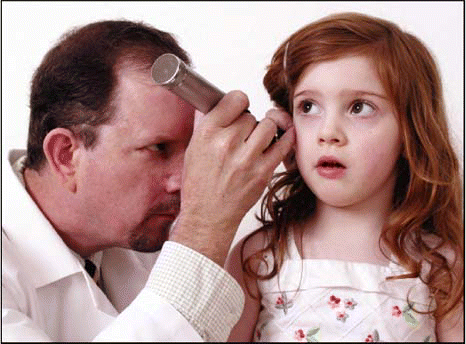There are few things more frustrating and upsetting for parents than watching their child suffer from the pain and discomfort of an ear infection. In the short term, the parents’ primary objective is typically to obtain some relief for their child. Many parents have concerns regarding the long-term effects from chronic or recurrent ear infections, however, based on the traditional belief that the child’s cognitive and functional skills could be irreversibly damaged by hearing loss caused by fluid lingering in the middle ear. Recent studies have indicated not only that the risk for these long-term effects be may much lower than previously believed, but also that more conservative treatment of ear infections in the short term may be effective.

Long-Term Effects of Otitis Media
According to a study published in Pediatrics, “Otitis Media in Early Childhood in Relation to Children’s School-Age Language and Academic Skills” (Pediatrics 2002;110:696–706), a child’s home environment is more predictive of language and academic outcomes than is a history of otitis media with effusion (OME) or hearing loss. The study found no significant relationship between a history of OME and children’s academic skills in reading or word recognition in early elementary school. Children suffering from a greater incidence of OME and hearing loss did score lower in math and expressive language skills at younger ages, but caught up with their peers by the time they reached second grade.
Joanne Roberts, PhD, Senior Scientist at the Frank Porter Graham Child Development Center at the University of North Carolina at Chapel Hill, and primary author of the Pediatrics study, stated, “Our research is finding little support for a history of chronic ear infections and associated hearing loss causing later difficulties. These data certainly do support a more conservative approach.”
With the level of risk for long-term effects called into question, a controversy now exists regarding whether traditional treatment of pediatric ear infections has been too aggressive, and whether, perhaps, the treatment itself is responsible for undesirable long-term effects.
‘Wait-and-See’ Approach to Antibiotic Usage
Physicians write approximately 15 million prescriptions annually in the United States for antibiotics to treat acute otitis media (AOM), at an estimated cost of $10 to $100 per course of therapy. The risks of antibiotics—including gastrointestinal upset, allergic reactions, and accelerated antibacterial resistance—have many researchers questioning whether the benefits of such widespread antibiotic therapy justify these risks.
The American Academy of Pediatrics and American Academy of Family Physicians Clinical Practice Guideline for Diagnosis and Management of Acute Otitis Media, published in Pediatrics in 2004, calls for “judicious use of antibacterial agents” (Pediatrics 2004;113:1451–1465). These guidelines endorse the option of observation without the use of antibacterial agents in a child with uncomplicated AOM based on diagnostic certainty, age, illness severity, and assurance of follow-up. This option refers to delaying the use of antibiotics for 48 to 72 hours for selected children. The guidelines cite studies over the past three decades consistently showing that between 7 and 20 children must be treated with antibacterial agents for one child to derive benefit. In placebo-controlled trials, 61% of children have decreased symptoms at 24 hours whether or not they received antibiotics.
In September of this year, JAMA published a study entitled, “Wait-and-See Prescription for the Treatment of Acute Otitis Media” by David M. Sprio, MD, et al. (JAMA 2006;296:1235–1241). Participants in the study were children between the ages of 6 months and 12 years who were diagnosed in an emergency department with AOM. The participants’ parents were given an antibiotic prescription that would expire three days following the child’s visit to the emergency department. Parents were instructed to fill the prescription if their child was not better, or was worse, 48 hours after their visit to the emergency department. Prescriptions were not filled for 62% of patients. The parents who did fill the prescription reported that they did so because of fever, otalgia, or fussy behavior. Follow-up at 4, 6, 11, and 14 days found that the rates of otalgia were not significantly different between patients who took antibiotics and those who did not. Furthermore, reported rates of diarrhea were two- to threefold higher in patients who took antibiotics immediately compared with patients in the “wait-and-see” group.
In the same issue of JAMA, Paul Little, MD, of the Community Clinical Sciences Division, University of Southampton, Southampton, UK, wrote an editorial on the subject entitled, “Delayed Prescribing—A Sensible Approach to the Management of Acute Otitis Media” (JAMA 2006;296:1290–1291). Dr. Little lists several potential advantages to delayed prescribing of antibiotics:
- Delayed prescribing rationalizes antibiotic use.
- Delayed prescribing changes patient and family beliefs about antibiotics.
- Delayed prescribing achieves acceptable symptom control.
Dr. Little concluded in his editorial that delayed prescribing of antibiotics is a reasonable approach when a child is not systemically ill and the physician has no major concerns about sicker or at-risk patients, including those with systemic symptoms, comorbidity, or those younger than six months. This school of thought is echoed in the American Academy of Pediatrics and American Academy of Family Physicians Clinical Practice Guidelines for Diagnosis and Management of Acute Otitis Media.
Kenneth Grundfast, MD, Professor and Chairman of the Department of Otolaryngology–Head and Neck Surgery at Boston University School of Medicine, whole-heartedly agrees with this approach to antibiotic usage for AOM. He thinks that too many children may have received too much antibiotic for ear infections for too long. He even cites recent studies that call into question the long-held notion that persistent fluid in the ears of young children causes delays in speech development or impairs cognitive ability in children. He states, “Watchful waiting is a major step back toward a rational process—doing what’s best for the patient.”
It is important to note that advocates of the wait-and-see approach for prescribing antibiotics emphasize that the child should be treated symptomatically for the pain associated with AOM, typically with ibuprofen and otic analgesic drops.
Ventilating Tubes
The insertion of ventilation tubes for treatment of chronic and recurrent OME is surrounded by controversy regarding effectiveness and long-term sequelae. For decades, placement of ventilation tubes has been recommended by physicians and accepted by parents as necessary to avoid having children suffer lasting developmental abnormalities as a result of lingering fluid in the middle ear. Several studies, including the Pediatrics study by Roberts et al., mentioned earlier, have shown evidence that any developmental lags experienced by children who suffer from chronic or recurrent OME is temporary, and they soon catch up to their peers.
The American Academy of Family Physicians; American Academy of Otolaryngology-Head and Neck Surgery; American Academy of Pediatrics Subcommittee on Otitis Media with Effusion Clinical Practice Guidelines, published in Pediatrics in 2004, advocate a more conservative approach to insertion of ventilation tubes (Pediatrics 2004;113:1412–1429). These guidelines recommend watchful waiting without surgical procedures, with 3- to 6- month reassessments of symptoms, hearing, and the development of tympanic membrane pathologic abnormalities for normal, asymptomatic children with hearing thresholds of less than 40 dB.
Additionally, in a study published in Archives of Pediatric and Adolescent Medicine in December 2005, Robert Stenstrom, MD, et al. concluded that placement of ventilation tubes may actually cause harm to children in the long-term. The study, entitled, “Hearing Thresholds and Tympanic Membrane Sequelae in Children Managed Medically or Surgically for Otitis Media With Effusion” (Arch Pediatr Adolesc Med 2005;159:1151–1156), showed that insertion of ventilation tubes was associated with a 4.5-fold increase in risk of myringosclerosis and a 9.9-fold risk of tympanic membrane abnormalities at 6- to 10-year follow-up. Hearing thresholds were significantly poorer (5–11 dB HL) in patients exposed to ventilation tubes when compared with those who were not.
In an editorial regarding this study in the same issue of Archives of Pediatric and Adolescent Medicine, Steven Berman, MD, Professor of Pediatrics at the University of Colorado Health Sciences Center, concurred with these findings (Arch Pediatr Adolesc Med 2005;159:1183–1185). Dr. Berman stated in his editorial that it is reasonable to conclude that the long-term effects of ventilating tubes are additive to age-related sensorineural hearing loss and noise-induced hearing loss, and that they can have an adverse effect later in life. For this reason, Dr. Berman said in a telephone interview that he believes 20-year and 30-year follow-up studies would be helpful in determining just how serious the risk of these potential sequelae may be.
Dr. Berman said that there are those in the ENT community who claim that the results of the Archives of Pediatric and Adolescent Medicine study by Stenstrom et al. may have been affected by the type of ventilating tubes that were used in the study, arguing that use of the newer, smaller tubes would not produce the same outcomes. His response to that argument is, “There is now evidence that there is a problem, and the responsibility is on the ENT community to document that the newer tubes are not associated with that problem. Rather than saying we don’t have the problem with the newer tubes, the onus is now on the ENT community to repeat the study with the new tubes. In the absence of those studies, people have to assume that there will be this effect.”
Dr. Grundfast opines that there may be too much emphasis on determining a number of ear infections that is “too many,” or a period of time that is “too long” for fluid to remain in the middle ear. He feels that the American Academy of Pediatrics and American Academy of Family Physicians guidelines advocate an approach to treatment that is moving away from the “cookbook approach” to practicing medicine.
He stated, “After so many years of controversy and searches for easy answers and formulaic approaches that would meet the need of societies and third-party payors, I firmly believe that children with otitis media are best served by having informed parents, having candid discussions with experienced otolaryngologists—who, with audiologists, have the ability to carefully examine the eardrums of children, and discuss with the parents any and all medical conditions or development problems that children may have—and analyzing the data obtained from otologic testing in order to make individual decisions about the best next step for each and every individual child.”
Dr. Berman and Dr. Grundfast agree that antibiotics and ventilating tubes both have their place in the treatment of AOM and OME, but that both conditions are more self-limiting than previously believed. Many factors must be taken into consideration by physicians and parents when making decisions regarding treatment, and even though more evidence is now available to assist with informed decision making, Dr. Berman cautions that there is more work to be done. He states, “I think the more answers we get, the more questions pop up.”
Dr. Grundfast concludes, “So many people have spent so much time looking at this from so many points of view, otolaryngologists now have the data they need. I have total confidence in the ability of otolaryngologists to make good decisions on behalf of their patients.”
©2006 The Triological Society


Leave a Reply